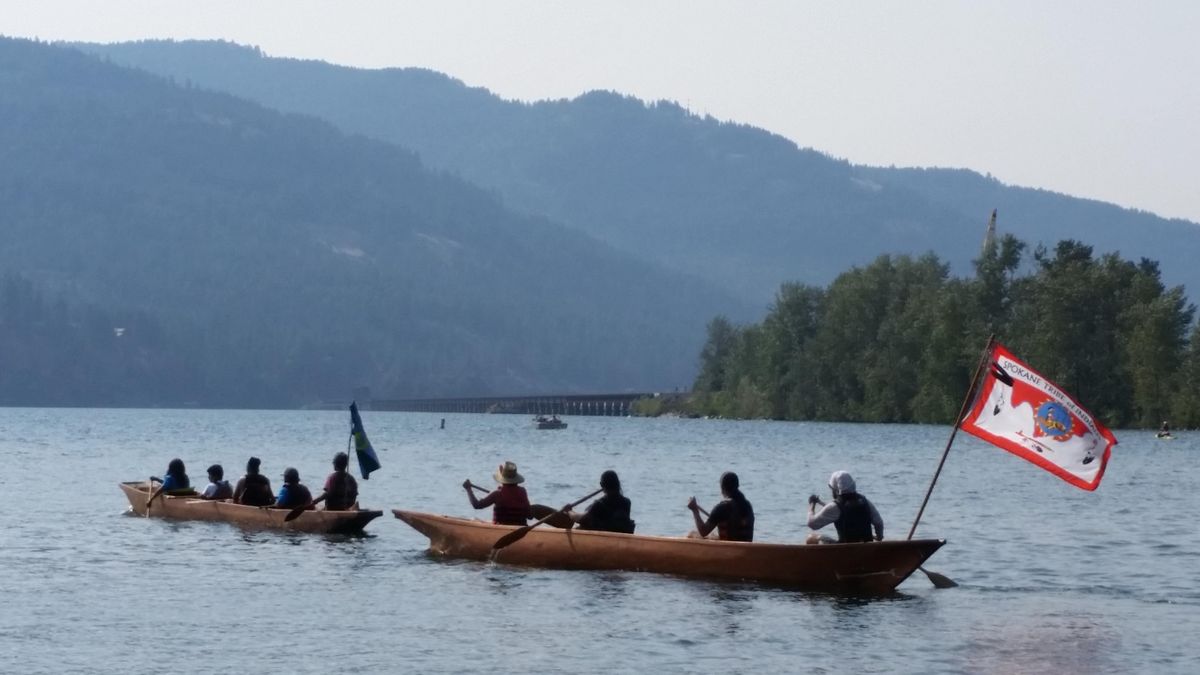Kalispel paddle the Pend Oreille in dugout canoes, embracing historic ties to the waterway

For the first time in about a century, members of the Kalispel Tribe paddled 51 miles down the Pend Oreille River in a traditional-style dugout canoe from Sandpoint to the tribe’s powwow grounds in Cusick, Washington.
The Kalispel were among the original inhabitants of North Idaho and historically met at various spots along the waterway. The route marks “headwaters to home, as in long past,” said Kalispel member Nathan Piengkham. “My ancestors would’ve done the same.”
Piengkham and other organizers of the trip dubbed it “Remember the Water” for Lake Pend Oreille and the river flowing out of it.
“I named the paddle ‘Remember the Water,’ because people need to remember that we still exist. People from those waters are still here,” said Piengkham.
At the Thursday launch of the event at Sandpoint City Beach, elders spoke of the need to bring salmon back to the upper reaches of the Columbia River watershed.
The Kalispels were joined by members of the Spokane and Coeur d’Alene tribes, who also paddled traditional dugout canoes.
The three canoes were among the boats created last year from six old-growth cedar logs sold to the Upper Columbia United Tribes by the Quinault Indian Nation in Western Washington. The Upper Columbia United Tribes – the Kootenai, Colville, Coeur d’Alene, Kalispel and Spokane – all received cedar logs estimated to be between 500 to 900 years old.
The Kalispels’ dugout canoe was created from one of the smaller logs, and it took members of the tribe six months to hollow the canoe using a variety of traditional and modern tools.
Members of the tribe said the Kalispels have not had a canoe like it in a century.
The dugout canoes have made a few long trips together already. The first was over the 2016 summer solstice to participate in the annual salmon ceremony at Kettle Falls on the Columbia River. This was the first time in 86 years that the tribes had paddled to Kettle Falls, after having done so for hundreds of years. The canoes made another trip to Kettle Falls this past June for the salmon ceremony.
“The canoes bring us together,” said Spokane Tribe member Shawn Brigman. “We set aside our differences and paddle together during canoe season.” Brigman has created and been involved in a number of cultural recovery projects since 2005, including building birch-bark canoes and tule mat lodges.
Brigman made the only Salish sturgeon-nose canoe on the paddle. The craft’s cedar skeleton was covered with a blue nylon skin, its silhouette mimicking “a human, an animal; the sturgeon.” The blue skin, he said, was in honor of the water and water protection. He took the canoe to the Standing Rock Indian Reservation last year and made a short paddle to the site where Native Americans were protesting the siting of the Dakota Access pipeline because of the risk it posed to the Missouri River watershed.
The three-day paddle down the Pend Oreille River concluded at the 42nd annual Kalispel Powwow, held last weekend and featuring dance and drum contests as well as a stick game tournament.
Katie Botkin is a freelance writer and the managing editor of MultiLingual magazine.